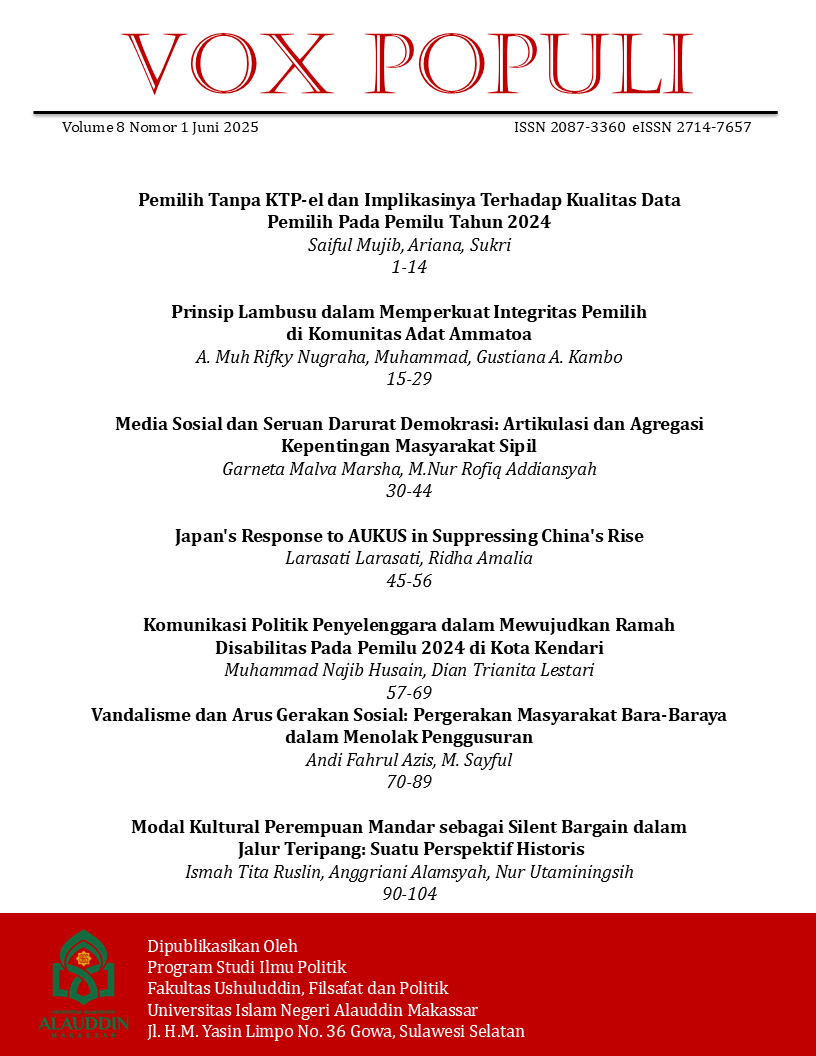Modal Kultural Perempuan Mandar sebagai Silent Bargain dalam Jalur Teripang: Suatu Perspektif Historis
DOI:
https://doi.org/10.24252/vp.v8i1.57254Keywords:
Perempuan, Mandar, Modal Budaya, Karoroq PadewakangAbstract
This study examines the authority of women in maritime culture through a historical analysis that underscores cultural dimensions as manifestations of gender. The historical pursuit of trepang (sea cucumbers) by seekers from the port of Makassar to Australia’s northern coast has continued from the 16th century to the early 20th century, commonly referred to as the trepang route. This study addresses women’s cultural capital, emphasising power dynamics that have been underrepresented in maritime cultural studies, particularly as shipping and commercial activities have predominantly been associated with male authority. This research employs Bourdieu’s concept of cultural capital to illustrate the expertise of Mandar women in weaving Karoroq (sail) for Padewakkang boats utilised in the trepang trade. The Karoroq sail plays a vital role in the Padewakkang voyage to Arnhem Land, Australia, where trepang were harvested. The Padewakkang vessel, which lacks an engine, is entirely propelled by its sails. This study not only highlights the technical involvement of women in preserving maritime cultural heritage but also explores how Mandar women have historically demonstrated their power through traditional knowledge and the reinforcement of cultural identity. Furthermore, this study illustrates the status of women as equals to men within the maritime culture of Sulawesi for several decades. The authors perceive women's efforts to leverage cultural capital in the trepang route as a silent negotiation.
References
Anwar, Z., & Wahyuni. (2019). Miskin di Laut yang Kaya. Sosioreligius: Jurnal Ilmiah So-siologi Agama, 4(1), 51–60.
Bahrum, S., & Anwar, D. (2009). Tenunan Tradisional Sutra Mandar di Sulawesi Barat. Direktorat Jenderal Nilai Budaya, Seni dan Film, Departemen Kebuadayaan dan Pariwisata.
Bourdieu, P. (2010). Arena Produksi Kultural: Sebuah Kajian Sosiologi Budaya (R. I. Muzir, Ed.). Kreasi Wacana.
Clark, M., & May, S. K. (2013). Macassan history and heritage: journeys, encounters and influ-ences. ANU Press.
Fajriati, I. T. (2024). Kekayaan Alam Hayati: Corypha Utan, Rahasia Dibalik Kemegahan Pohon Gebang. https://gebangpark.com/Rahasia-Di-Balik-Kemegahan-Pohon-Gebang/
Fitriani. (2021). Peran International Maritime Organization (IMO) dalam Pemberdayaan Perempuan di Komunitas Maritim Malaysia. JOM FISIP, 8(2), 1–11.
Harper, S., Grubb, C., Stiles, M., & Sumaila, U. R. (2017). Contributions by Women to Fisheries Economies: Insights from Five Maritime Countries. Coastal Management, 45(2), 91–106. https://doi.org/10.1080/08920753.2017.1278143
Haryadi, R. (2017). Padewakang Kapal Rempah Pertama Nusantara. https://www.gatra.com/budaya-1/294600-padewakang-kapal-rempah-pertama-nusantara.
Ismi, N. (2022). Peran Padewakang dalam Pelayaran Niaga di Makassar Pada Abad ke-19. Universitas Hasanuddin.
Kasim, S. S. (2023). Relasi Gender dalam Pengelolaan Sumber Daya Pesisir Pada Ne-layan Tangkap: Perspektif Teori Feminisme Liberal. Jurnal Neo Societal, 8(3), 170–180.
Kawarazuka, N., Locke, C., & Seeley, J. (2019). Women bargaining with patriarchy in coastal Kenya: contradictions, creative agency and food provisioning. Gender, Place and Culture, 26(3), 384–404. https://doi.org/10.1080/0966369X.2018.1552559
Klimczuk, A. (2015). Cultural Capital. In The Wiley Blackwell Encyclopedia of Consumption and Consumer Studies (pp. 1–3). Wiley. https://doi.org/10.1002/9781118989463.wbeccs083
Litha, D. R., Awaru, A. O. T., Aulia, N., Muqmi, S. I., & Ramadhani, A. (2023). Strategi Pemberdayaan Perempuan Melalui Kelompok Wanita Nelayan Fatimah Azzarah Kota Makassar. Social Landscape Journal, 4(2), 74–81.
Macknight, C. C. (1976). The Voyage to Marege: Macassan Trepangers in Northen Australia. Melbourne University Press.
Mahyuddin, Wahyuddin, M., & Wahyuni. (2020). Keluarga Nelayan dan Budaya Sibaliparri’: Menyingkap Relasi Kesetaraan Gender dalam Masyarakat Mandar. AL-MAIYYAH: Media Transformasi Gender Dalam Paradigma Sosial Keagamaan, 13(1), 77–89.
Mellefont, J. (2018). UNESCO Heritage-List Indonesia Wooden Boat Building. https://www.newmandala.org/unesco-heritage-lists-indonesian-wooden-boat-building/
Newman, L. (2003). Social Research Methods: Qualittaive and Quantitative Approaches (5th ed.). Allyn and Bacon.
Pelras, C. (2006). Manusia Bugis. Angkasa.
Reid, A. (1990). An “Age of Commerce” in Southeast Asian History. Modern Asian Stud-ies, 24(1), 1–30.
Ruslin, I. T., & Zainal, N. A. (2019). Akumulasi Kapital dan Eksistensi Negara: Analisis Pemberdayaan Kelompok Wanita Nelayan (KWN) di Kelurahan Pattingalloang Kota Makassar. Jurnal Politik Profetik, 7(1), 80-95.
S Tri. (2019, December). Wawancara Khusus Ridwan Alimuddin: Padewakang, Antara Misi Budaya dan Agama. https://sulbarkita.com/wawancara_khusus_ridwan_alimuddin_padewakang_antara_misi_budaya_dan_agama_berita727.html.
Sahabuddin, C. (2013). PANETTE: Sebuah Sistem Silbalaparri dalam Keluarga Man-dar. Pepatuzdu, 5(1), 59–69.
Salim, S., Fikri, A., Margiyanti, D. A. S., Arwinda, M. D., Fiki, Ferdhiyadi, Damayanti, D., Sala, W. Y., Jasin, A., & Isra, A. B. Al. (2024). Jalur Teripang: Jejak dan Pemak-naan Baru Seratus Tahun Kemudian (N. Utaminingsih & A. J. Rachman, Eds.). Inin-nawa.
Schwerdtner Máñez, K., & Ferse, S. C. A. (2010). The History of Makassan Trepang Fishing and Trade. PLoS ONE, 5(6), e11346. https://doi.org/10.1371/journal.pone.0011346
Sonni, A. F., Amrullah, M., & Bahfiarty, T. (2021). The Symbolic Meaning of the Sandeq Boat Making Process Among Mandarese. Etnosia: Jurnal Etnografi Indonesia, 6(2), 184–199.
Thamrin, M. Y. (2020, May). Selidik Pelayaran Marege: Meniti Jejak Leluhur Makassar ke Australia. https://nationalgeographic.grid.id/read/132151972/selidik-pelayaran-marege-meniti-jejak-leluhur-makassar-ke-australia?page=all.
Tol, R., Dijk, K. van, & Acciaioli, G. (2009). Kuasa dan Usaha di Masyarakat Sulawesi Se-latan. Ininnawa dan KITLV-Jakarta.
Volkman, A. T. (1994). Our Garden is The Sea: Contingency and Improvisation in Mandar Women’s Work. American Etnologist, 21(3), 564–585.
Wajuanna, A. Y. P. (2024). Prospek Karir dan Faktor Kendala Pelaut Wanita pada Perus-ahaan Pelayaran Nasional. Universitas Hasanuddin.
Yakub, B. U., Husain, H., Nurdin, A., Nurhayati, N., & Hidayatulloh, M. K. (2023). Living Qur’an, Gender, and Sibaliparriq, in Mandar, Indonesia: Cultural Construc-tion in the Perspective of Islamic Law. Samarah: Jurnal Hukum Keluarga Dan Hukum Islam, 7(2), 1219. https://doi.org/10.22373/sjhk.v7i2.17892
Zazzaro, C., Liebner, H., Soriente, A., Ferraioli, G., & Purnawibawa, A. G. (2022). The Construction of an Historical Boat in South Sulawesi (Indonesia): The Padewak-ang. Journal of Maritime Archaeology, 17(4), 507–557. https://doi.org/10.1007/s11457-022-09332-5
Downloads
Published
Issue
Section
License
Copyright (c) 2025 Ismah Tita Ruslin, Anggriani Alamsyah, Nur Utaminingsih

This work is licensed under a Creative Commons Attribution-NonCommercial-ShareAlike 4.0 International License.
Vox Populi uses license CC-BY-NA-SA or equivalent license as the optimal license use for publication, distribution, use, and reuse of scientific works. To see the rules, you can look here; Indonesia or English.







